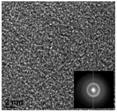
Since their discovery fifty years ago, metallic glasses were extensively investigated for better understanding their original functional properties, linked to their amorphous structure. Due to a severe elaboration complexity, such materials are still not well-developed at an industrial scale. The new challenge nowadays concerns metallic glasses in the form of thin films using physical vapour deposition processes (PVD), well-adapted for depositing advanced disordered structures. We propose to study this rupture-solution, in order to synthesize a new generation of resistant anti-microbial films.
Antibacterial characteristics are afforded by the recognized efficient silver metal, associated to a smooth amorphous structure, prone to limit adhesion of the bio-film, signs of bacterial growth. Moreover, magnetron sputtering is a very versatile process, able to easily tune films' chemistry, allowing a fine control of the surface's bio-activity with the silver content from a bio-static character (non-proliferation) to a biocide effect.
For this ambitious objective, two complementary laboratories are involved: the Institut Jean LAMOUR from the Université de Lorraine and the MATEIS laboratory from INSA de Lyon representing both Carnot Instituts ICÉEL and I@L respectively. First laboratory is in charge of the films' synthesize and of their fine in situ analysis, while MATEIS proposes their physic-chemical and biological characterization in relation with their microstructure determined at several scales (SEM, TEM). From a human aspect, the projet will involve a 2 year-post-doctorant (only one requested within the framework of the current InterCarnot project), together with 2 years of a research and teaching assistant.
Development of such innovative "smart surfaces" could be, from the public health viewpoint, a new tool to prevent nosocomial infections. On the other hand, this project could strengthen health based-SMB's skill, industrial activity well-developed in the Rhône-Alpes region.
Keywords: Thin film metallic glasse, Ag, physico-chemistry, microstructure, antimicrobial activity, biocompatibility
![]()

